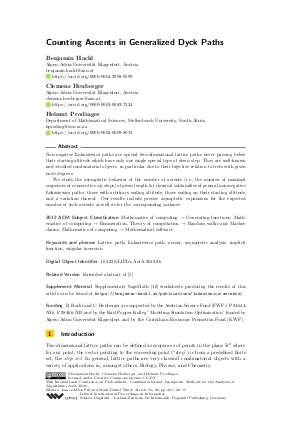Counting Ascents in Generalized Dyck Paths
Authors
Benjamin Hackl  ,
Clemens Heuberger
,
Clemens Heuberger  ,
Helmut Prodinger
,
Helmut Prodinger 
-
Part of:
Volume:
29th International Conference on Probabilistic, Combinatorial and Asymptotic Methods for the Analysis of Algorithms (AofA 2018)
Part of: Series: Leibniz International Proceedings in Informatics (LIPIcs)
Part of: Conference: International Conference on Probabilistic, Combinatorial and Asymptotic Methods for the Analysis of Algorithms (AofA) - License:
 Creative Commons Attribution 3.0 Unported license
Creative Commons Attribution 3.0 Unported license
- Publication Date: 2018-06-18
File

PDF
LIPIcs.AofA.2018.26.pdf
- Filesize: 442 kB
- 15 pages
Document Identifiers
Related Versions
-
Extended abstract of [Hackl et al., 2018]
Subject Classification
ACM Subject Classification
- Mathematics of computing → Generating functions
- Mathematics of computing → Enumeration
- Theory of computation → Random walks and Markov chains
- Mathematics of computing → Mathematical software
Keywords
- Lattice path
- Lukasiewicz path
- ascent
- asymptotic analysis
- implicit function
- singular inversion
Metrics
- Access Statistics
-
Total Accesses (updated on a weekly basis)
0Document
0Metadata
Abstract
Non-negative Lukasiewicz paths are special two-dimensional lattice paths never passing below their starting altitude which have only one single special type of down step. They are well-known and -studied combinatorial objects, in particular due to their bijective relation to trees with given node degrees. We study the asymptotic behavior of the number of ascents (i.e., the number of maximal sequences of consecutive up steps) of given length for classical subfamilies of general non-negative Lukasiewicz paths: those with arbitrary ending altitude, those ending on their starting altitude, and a variation thereof. Our results include precise asymptotic expansions for the expected number of such ascents as well as for the corresponding variance.
Cite As Get BibTex
Benjamin Hackl, Clemens Heuberger, and Helmut Prodinger. Counting Ascents in Generalized Dyck Paths. In 29th International Conference on Probabilistic, Combinatorial and Asymptotic Methods for the Analysis of Algorithms (AofA 2018). Leibniz International Proceedings in Informatics (LIPIcs), Volume 110, pp. 26:1-26:15, Schloss Dagstuhl – Leibniz-Zentrum für Informatik (2018)
https://doi.org/10.4230/LIPIcs.AofA.2018.26
BibTex
@InProceedings{hackl_et_al:LIPIcs.AofA.2018.26,
author = {Hackl, Benjamin and Heuberger, Clemens and Prodinger, Helmut},
title = {{Counting Ascents in Generalized Dyck Paths}},
booktitle = {29th International Conference on Probabilistic, Combinatorial and Asymptotic Methods for the Analysis of Algorithms (AofA 2018)},
pages = {26:1--26:15},
series = {Leibniz International Proceedings in Informatics (LIPIcs)},
ISBN = {978-3-95977-078-1},
ISSN = {1868-8969},
year = {2018},
volume = {110},
editor = {Fill, James Allen and Ward, Mark Daniel},
publisher = {Schloss Dagstuhl -- Leibniz-Zentrum f{\"u}r Informatik},
address = {Dagstuhl, Germany},
URL = {https://drops.dagstuhl.de/entities/document/10.4230/LIPIcs.AofA.2018.26},
URN = {urn:nbn:de:0030-drops-89191},
doi = {10.4230/LIPIcs.AofA.2018.26},
annote = {Keywords: Lattice path, Lukasiewicz path, ascent, asymptotic analysis, implicit function, singular inversion}
}
Author Details
Funding
B. Hackl and C. Heuberger are supported by the Austrian Science Fund (FWF): P 24644-N26, P 28466-N35 and by the Karl Popper Kolleg "Modeling-Simulation-Optimization" funded by Alpen-Adria-Universität Klagenfurt and by the Carinthian Economic Promotion Fund (KWF).
Supplementary Materials
- Supplementary SageMath [SageMath Mathematics Software (Version 8.1), 2017] worksheets producing the results of this article can be found at https://benjamin-hackl.at/publications/lukasiewicz-ascents/.
References
- Cyril Banderier and Philippe Flajolet. Basic analytic combinatorics of directed lattice paths. Theoret. Comput. Sci., 281(1-2):37-80, 2002. URL: http://dx.doi.org/10.1016/S0304-3975(02)00007-5.
- David Bevan. Permutations avoiding 1324 and patterns in Łukasiewicz paths. J. Lond. Math. Soc. (2), 92(1):105-122, 2015. URL: http://dx.doi.org/10.1112/jlms/jdv020.
- Philippe Flajolet and Robert Sedgewick. Analytic combinatorics. Cambridge University Press, Cambridge, 2009. URL: http://dx.doi.org/10.1017/CBO9780511801655.
-
Ronald L. Graham, Donald E. Knuth, and Oren Patashnik. Concrete mathematics. A foundation for computer science. Addison-Wesley, second edition, 1994.

- Benjamin Hackl, Clemens Heuberger, and Helmut Prodinger. Ascents in non-negative lattice paths. arXiv:1801.02996 [math.CO], 2018. URL: https://arxiv.org/abs/1801.02996.
- Kairi Kangro, Mozhgan Pourmoradnasseri, and Dirk Oliver Theis. Short note on the number of 1-ascents in dispersed Dyck paths. arXiv:1603.01422 [math.CO], 2016. URL: https://arxiv.org/abs/1603.01422.
- M. Lothaire. Combinatorics on words. Cambridge Mathematical Library. Cambridge University Press, Cambridge, 1997. With a foreword by Roger Lyndon and a preface by Dominique Perrin, Corrected reprint of the 1983 original, with a new preface by Perrin. URL: http://dx.doi.org/10.1017/CBO9780511566097.
- Amram Meir and John W. Moon. On an asymptotic method in enumeration. J. Combin. Theory Ser. A, 51(1):77-89, 1989. URL: http://dx.doi.org/10.1016/0097-3165(89)90078-2.
- Helmut Prodinger. Returns, hills, and t-ary trees. J. Integer Seq., 19(7):Article 16.7.2, 8, 2016. URL: https://www.emis.de/journals/JIS/VOL19/Prodinger/prod41.html.
- The SageMath Developers. SageMath Mathematics Software (Version 8.1), 2017. URL: http://www.sagemath.org.
